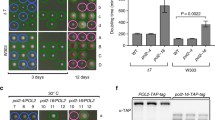Abstract
Using a genetic approach, Chinese hamster ovary (CHO) cells sensitive (aphS) and resistant (aphR) to aphidicolin were grown in the presence or absence of various DNA polymerase inhibitors, and the newly synthesized DNA isolated from [32P]dNMP-labelled, detergent-permeabilized cells, was characterized after fractionation by gel electrophoresis. The particular aph Rmutant CHO cell line used was one selected for resistance to aphidicolin and found to possess an altered DNA polymerase of the a-family. The synthesis of a 24 kb replication intermediate was inhibited in wild-type CHO cells grown in the presence of aphidicolin, whereas the synthesis of this replication intermediate was not inhibited by this drug in the mutant CHO cells or in the aphidicolin-resistant somatic cell hybrid progeny constructed by fusion of wild-type and mutant cell lines. Arabinofuranosylcytosine (ara-C), like aphidicolin, inhibited the synthesis of this 24 kb DNA replication intermediate in the wild-type CHO cells but not in the aphR mutant cells. However, carbonyldiphosphonate (COMDP) inhibited the synthesis of the 24 kb replication intermediate in both wild-type and mutant cells. N2-(p-n-Butylphenyl)-2′ deoxyguanisine-5′-triphosphate (BuPdGTP) was found to inhibit the formation of Okazaki fragments equally well in the wild-type and mutant cell lines and thus led to inhibition of synthesis of DNA intermediates in both cases. It appears that aphidicolin and ara-C both affect a common target on the DNA polymerase, which is different from that affected by COMDP in vivo. These data also show that aphidicolin, ara-C and COMDP affect the elongation activity of DNA polymerase but not the initiation activity of the enzyme during DNA replication. This is the first report of such differentiation of the DNA polymerase activities during nuclear DNA replication in mammalian cells. The method of analysis described here for replication intermediates can be used to examine the inhibitory activities of other chemicals on DNA synthesis.
Similar content being viewed by others
References
Bambara RA, Jesse CB (1991) Properties of DNA polymerase δ and ɛ and their roles in eukaryotic DNA replication. Biochim Biophys Acta 1088:11–24
Bullock PA, Seo YS, Hurwitz J (1991) Inhibition of SV40 DNA synthesis in vitro. Mol Cell Biol 11:2350–2361
Burgers PMJ (1991) Saccharomyces cerevisiae replication factor C. J Biol Chem 266:22698–22707
Campbell J (1986) Eukaryotic DNA replication. Annu Rev Biochem 55:733–771
Challberg MD, Kelly T (1989) Animal virus DNA replication. Annu Rev Biochem 58:671–717
Cohen SS (1977) The mechanism of lethal action of ara-C and ara-A. Cancer 40:509–518
Cooley M, Mishra CN (1994) Analysis of DNA replication products in Saccharomyces cerevisiae1 (abstract). Yeast genetics and molecular biology meetings 1994, Seattle, Wash., p 113
Decker RS, Yamaguchi M, Possenti R, DePamphilis M (1986) Initiation of simian virus 40 DNA replication in vitro: aphidicolin causes accumulation of early replication intermediates and allows determination of initial direction of DNA synthesis. Mol Cell Biol 6:3815–3825
Feher Z, Mishra NC (1994) Aphidicolin resistant Chinese hamster ovary cells possess altered DNA polymerases of the α-family. Biochim Biophys Acta 1218:35–47
Hammond RA, Byrnes JJ, Miller MR (1987) Identification of DNA polymerase δ in CV-1 cells; studies implicate both DNA pol δ and DNA pol α in DNA replication. Biochemistry 26:6817–6824
Hartwell L, Weinert TA (1989) Checkpoints: controls that ensure the order of cell cycle events. Science 246:629–634
Huberman J (1981) A new view of the biochemistry of eukaryotic DNA revealed by aphidicolin, an unusual inhibitor of DNA pol α. Cell 23:647–648
Hubscher U, Thomas P (1992) DNA polymerase ɛ: in search of a function. Trends Biochem Sci 16:55–58
Ikegami S, Taguchi T, Ohasin M, Oguro M, Nagano H, Mano Y (1979) Selective inhibition by aphidicolin of the activity of DNA polymerase α leads to blockage of DNA synthesis and cell division in sea urchin embryos. Dev Growth Differ 21:119–127
Ishimi Y, Claude A, Bullock P, Hurwitz J (1988) Complete enzymatic synthesis of DNA containing the SV40 origin of replication. J Biol Chem 263:19723–19733
Kornberg A, Baker A (1992) DNA replication. K.B. Freeman, San Francisco
Lee SH, Eki T, Hurwitz J (1989) Synthesis of DNA. DNA containing the SV40 origin of replication by the combined action of DNA pol α and δ. Proc Natl Acad Sci USA 86:7361–7365
Lee S-H, Pan Z-Q, Wong ADK, Burgers PMJ, Hurwitz J (1991) Synthesis of DNA by DNA polymerase ɛ in vitro. Mol Cell Biol 11:2350–2361
Linn S (1991) How many pols does it take to replicate nuclear DNA? Cell 66:185–187
Lonn U, Lonn S (1983) Aphidicolin inhibits the synthesis and joining of short DNA fragments but not the union of 10 kilobase DNA intermediates. Proc Natl Acad Sci USA 80:3996–3999
Miller MR, Castellot JJ, Pardee AB (1979) A permeable animal cell preparation for studying macro molecular synthesis. Biochem. 17:1073–1080
Morrison A, Araki H, Clark AB, Hamatake RK, Sugino A (1990) A third essential DNA polymerase in S. cerevisiae. Cell 62:1143–1151
Nethanel T, Kaufmann G (1990) Two DNA polymerases may be required for synthesis of the lagging DNA strand of simian virus 40. J Virol 64:5912–5918
Oguro M, Suzuki-Hori C, Nagano H, Mano Y, Ikegami S (1979) The mode of inhibitory action by aphidicolin on eukaryotic DNA polymerase α. Eur J Biochem 97:603–607
Perlich G, Stillman B (1988) Coordinated leading and lagging strand synthesis during SV40 DNA replication in vitro requires PCNA. Cell 53:117–126
Podust V, Mikhailov V, Georgaki A, Hubscher U (1992) DNA polymerase δ and α holoenzymes from calf thymus. Chromosoma 102:5133–5142
Sheaff R, Icsley D, Kuchta R (1991) Mechanism of DNA polymerase a inhibition by aphidicolin. Biochemistry 30:8590–8597
Siegel G, Turchi JJ, Myers TW, Bambara RA (1992) A 5′→3′ exonuclease functionally interacts with calf DNA polymerase ɛ. Proc Natl Acad Sci USA 89:9377–9381
Singleton RW (1993) Analysis of DNA replication in CHO cell lines sensitive and resistant to replicative inhibitors. PhD dissertation, The University of South Carolina, Columbia, SC 29208
So AG, Downey KM (1992) Eukaryotic DNA replication. Crit Rev Biochem Mol Biol 27:129–155
Spadari S, Sala F, Pedrali-Noy G (1982) Aphidicolin: a specific inhibitor of nuclear DNA replication in eukaryotes. Trends Biochem Sci 7:29–33
Syvaoja J, Suomensaari S, Nishida C, Goldsmith J, Chui G, Jain S, Linn S (1990) DNA polymerase α, δ, and ɛ: three distinct enzymes from HeLa cells. Proc Natl Acad Sci USA 87:6664–6668
Talanian R, Brown NC, McKenna CE, Ye TG, Levy JN, Wright GE (1980) Carbonyldiphosphonate, a selective inhibitor of mammalian DNA polymerase δ. Biochemistry 28:8270–8274
Tsurimoto T, Malendy T, Stillman B (1990) Sequential initiation of lagging and leading strand synthesis by two different polymerase complexes at SV40 DNA replication origin. Nature 346:534–539
Tsurimoto T, Stillman B (1991) Replication factors required for SV40 DNA replication in vitro. J Biol Chem 266:1950–1960
Waga S, Stillman B (1994) Anatomy of a DNA replication fork revealed by reconstitution of SV40 DNA replication in vitro. Nature 369:207–212
WangT S-F (1991) Eukaryotic DNA polymerases. Annu Rev Biochem 60:513–552
Weinberg DH, Collins KL, Simanak P, Russo A, Wold MC, Virshup DA, Kelly TJ (1990) Reconstitution of SV40 DNA replication with purified proteins. Proc Natl Acad Sci USA 87:8692–8696
Weinberg DH, Kelly TJ (1989) Requirement for two DNA polymerases in the replication of SV40 DNA in vitro. Proc Natl Acad Sci USA 86:9742–9746
Author information
Authors and Affiliations
Additional information
Communicated by K. Illmensee
Rights and permissions
About this article
Cite this article
Singleton, R.W., Mishra, N.C. Genetic evidence that aphidicolin inhibits in vivo DNA synthesis in Chinese hamster ovary cells. Molec. Gen. Genet. 247, 462–470 (1995). https://doi.org/10.1007/BF00293148
Received:
Accepted:
Issue Date:
DOI: https://doi.org/10.1007/BF00293148




